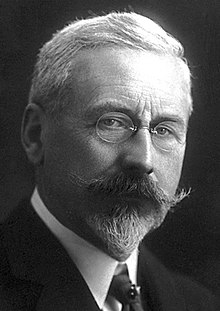Loading AI tools
Swiss physicist (1861–1938 From Wikipedia, the free encyclopedia
Charles Édouard Guillaume (15 February 1861 – 13 May 1938) was a Swiss physicist who received the Nobel Prize in Physics in 1920 "for the service he had rendered to precision measurements in physics by his discovery of anomalies in nickel steel alloys".[1] In 1919, he gave the fifth Guthrie Lecture at the Institute of Physics in London with the title "The Anomaly of the Nickel-Steels".[2]
Charles Édouard Guillaume | |
|---|---|
 Guillaume in 1920 | |
| Born | 15 February 1861 |
| Died | 13 May 1938 (aged 77) |
| Alma mater | ETH Zurich |
| Known for | Discoveries of invar and elinvar |
| Awards |
|
| Scientific career | |
| Fields | Physics |
| Institutions | International Bureau of Weights and Measures |
Charles-Edouard Guillaume was born in Fleurier, Switzerland, on 15 February 1861.[3] Guillaume received his early education in Neuchâtel, and obtained a doctoral degree in Physics at ETH Zurich in 1883.[3][4]
Guillaume was married in 1888 to A. M. Taufflieb, with whom he had three children.[3]
He died on 13 May 1938 at Sèvres, aged 77.
Guillaume was head of the International Bureau of Weights and Measures.[5][6] He also worked with Kristian Birkeland, serving at the Observatoire de Paris – Section de Meudon. He conducted several experiments with thermostatic measurements at the observatory.

Guillaume is known for his discovery of nickel–steel alloys he named invar,[7] elinvar and platinite, also known as red platinum. Invar has a near-zero coefficient of thermal expansion, making it useful in constructing precision instruments whose dimensions need to remain constant in spite of varying temperature. Elinvar has a near-zero thermal coefficient of the modulus of elasticity, making it useful in constructing instruments with springs that need to be unaffected by varying temperature, such as the marine chronometer. Elinvar is also non-magnetic, which is a secondary useful property for antimagnetic watches.
Guillaume is also known for the earliest estimation of the "radiation of the stars” in his 1896 article "La Température de L'Espace" ("The Temperature of Space"). This publication made him a pioneer in plasma cosmology, the study of conditions far from any particular star.[8] The concept was later known as the Cosmic microwave background.[9] He was one of the first people in history to estimate the temperature of space, as 5–6 K.[9]

As the son of a Swiss horologist, Guillaume took an interest in marine chronometers. For use as the compensation balance he developed a slight variation of the invar alloy which had a negative quadratic coefficient of expansion. The purpose of doing this was to eliminate the "middle-temperature" error of the balance wheel.[5] The Guillaume balance (a type of balance wheel) in horology is named after him.[10][11]
Seamless Wikipedia browsing. On steroids.
Every time you click a link to Wikipedia, Wiktionary or Wikiquote in your browser's search results, it will show the modern Wikiwand interface.
Wikiwand extension is a five stars, simple, with minimum permission required to keep your browsing private, safe and transparent.